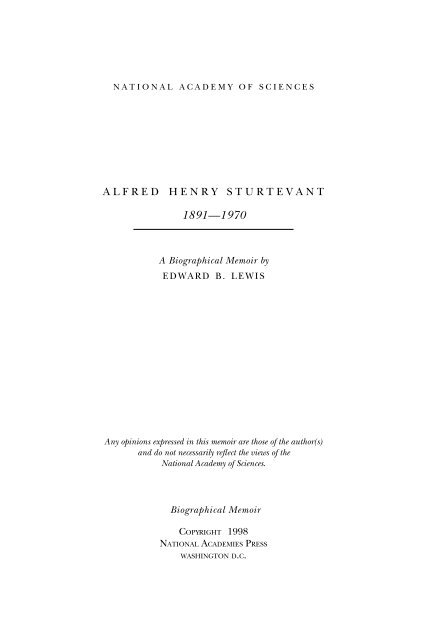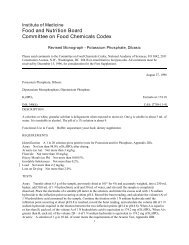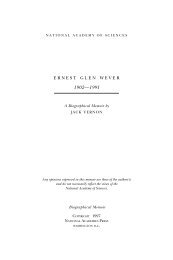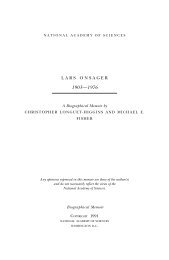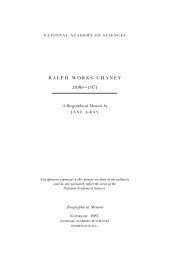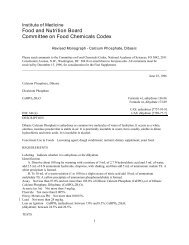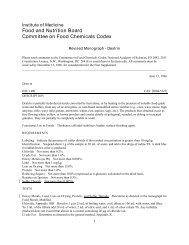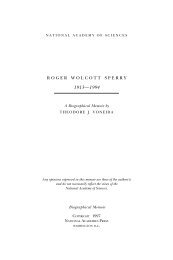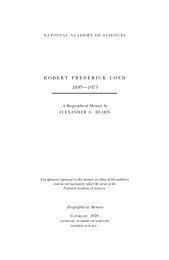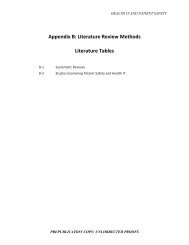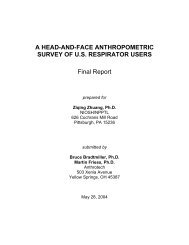ALFRED HENRY STURTEVANT - National Academy of Sciences
ALFRED HENRY STURTEVANT - National Academy of Sciences
ALFRED HENRY STURTEVANT - National Academy of Sciences
You also want an ePaper? Increase the reach of your titles
YUMPU automatically turns print PDFs into web optimized ePapers that Google loves.
n a t i o n a l a c a d e m y o f s c i e n c e s<br />
A l f r e d H e n r y S t u r t e v a n t<br />
1891—1970<br />
A Biographical Memoir by<br />
E d w a r d B . L e w i s<br />
Any opinions expressed in this memoir are those <strong>of</strong> the author(s)<br />
and do not necessarily reflect the views <strong>of</strong> the<br />
<strong>National</strong> <strong>Academy</strong> <strong>of</strong> <strong>Sciences</strong>.<br />
Biographical Memoir<br />
Copyright 1998<br />
<strong>National</strong> Academies Press<br />
washington d.c.
Courtesy <strong>of</strong> the Institute Archives, California Institue <strong>of</strong> Technology, Pasadena
<strong>ALFRED</strong> <strong>HENRY</strong> <strong>STURTEVANT</strong><br />
November 21, 1891—April 5, 1970<br />
BY EDWARD B. LEWIS<br />
TURTEVANT WAS THE youngest <strong>of</strong> six children <strong>of</strong> Alfred<br />
SHenry Sturtevant and Harriet Evelyn Morse. His grandfather<br />
Julian M. Sturtevant graduated from Yale Divinity<br />
School and was a founder and later president <strong>of</strong> Illinois<br />
College. Sturtevant’s father taught mathematics for a time<br />
at Illinois College but subsequently turned to farming, first<br />
in Illinois and later in southern Alabama, where the family<br />
moved when Sturtevant was seven. His early education was<br />
in Alabama in a one-room country school, but for the last<br />
three years <strong>of</strong> high school he went to a public school in<br />
Mobile.<br />
In the fall <strong>of</strong> 1908 Sturtevant entered Columbia University.<br />
The choice, a crucial one, was made because Sturtevant’s<br />
oldest brother, Edgar, was then teaching Latin and Greek<br />
at Barnard College; Edgar and his wife made it possible<br />
for Sturtevant to attend the university by taking him into<br />
their home. Sturtevant was greatly influenced by Edgar,<br />
from whom he learned the aims and standards <strong>of</strong> scholarship<br />
and research.<br />
As a boy Sturtevant had drawn up the pedigrees <strong>of</strong> his<br />
father’s horses and <strong>of</strong> his own family. He pursued this inter-<br />
Reprinted with permission from Dictionary <strong>of</strong> Scientific Biography, vol. 13, pp.133-38.<br />
New York: Chas. Scribner’s Sons, 1976.<br />
3
4 BIOGRAPHICAL MEMOIRS<br />
est as a hobby while he was at Columbia. Edgar encouraged<br />
him to read works on heredity and to learn more<br />
about the meaning <strong>of</strong> pedigrees. As a result Sturtevant<br />
read a book on Mendelism by Punnett that greatly stimulated<br />
his interest, since he saw how Mendel’s principles<br />
could be used to explain the pattern <strong>of</strong> inheritance <strong>of</strong><br />
certain coat colors in horses. Edgar suggested that Sturtevant<br />
work out the genetic relationships, write an account <strong>of</strong> his<br />
findings, and submit it to Thomas Hunt Morgan, who held<br />
the chair <strong>of</strong> experimental zoology at Columbia and from<br />
whom Sturtevant had already taken a course. Morgan clearly<br />
was impressed, since he not only encouraged Sturtevant to<br />
publish the account, which appeared in Biological Bulletin<br />
in 1910, but also, in the fall <strong>of</strong> that year, gave Sturtevant a<br />
desk in his laboratory, which came to be known as the “fly<br />
room.” Only a few months before, Morgan had found the<br />
first white-eyed mutant in Drosophila and had worked out<br />
the principles <strong>of</strong> sex linkage.<br />
After completing his doctoral work with Morgan in 1914,<br />
Sturtevant remained at Columbia as a research investigator<br />
for the Carnegie Institution <strong>of</strong> Washington. He was a<br />
member <strong>of</strong> a research team that Morgan had assembled a<br />
few years earlier and that consisted principally <strong>of</strong> two other<br />
students <strong>of</strong> Morgan’s, C. B. Bridges and H. J. Muller. The<br />
“fly room” in which they conducted all <strong>of</strong> their experiments<br />
was only sixteen by twenty-three feet, and at times<br />
as many as eight people had desks in it. According to<br />
Sturtevant, the atmosphere was one <strong>of</strong> high excitement,<br />
each new idea being freely put forth and debated. Morgan,<br />
Bridges, and Sturtevant remained at Columbia until 1928;<br />
Muller left the group in 1921 to take a position at the<br />
University <strong>of</strong> Texas.<br />
In 1922 Sturtevant married Phoebe Curtis Reed; and in<br />
the same year they made their first trip to Europe, visiting
<strong>ALFRED</strong> <strong>HENRY</strong> <strong>STURTEVANT</strong><br />
museums and laboratories in England, Norway, Sweden,<br />
and Holland. They had three children.<br />
In 1928 Sturtevant moved to Pasadena to become pr<strong>of</strong>essor<br />
<strong>of</strong> genetics in the new division <strong>of</strong> biology that Morgan<br />
had established in that year at the California Institute<br />
<strong>of</strong> Technology. Much <strong>of</strong> the same stimulating atmosphere<br />
and unpretentious way <strong>of</strong> conducting science that Morgan<br />
and his students had practiced at Columbia was transferred<br />
to the new Kerckh<strong>of</strong>f Laboratory at Caltech. Sturtevant<br />
became the acknowledged and natural leader <strong>of</strong> the new<br />
genetics group established there. He maintained an active<br />
research program in which he <strong>of</strong>ten collaborated with other<br />
members <strong>of</strong> the genetics staff, including George W. Beadle,<br />
Theodosius Dobzhansky, Sterling Emerson, and Jack Schultz.<br />
He gave lectures in the general biology course and taught<br />
elementary and advanced courses in genetics and, on occasion,<br />
a course in entomology. He remained at Caltech until<br />
his death except for a year in England and Germany in<br />
1932, as visiting pr<strong>of</strong>essor <strong>of</strong> the Carnegie Endowment for<br />
International Peace, and shorter periods when he held visiting<br />
pr<strong>of</strong>essorships at a number <strong>of</strong> American universities.<br />
He received many honors, including the <strong>National</strong> Medal<br />
<strong>of</strong> Science in 1968.<br />
In addition to his principal publications dealing with<br />
the genetics and taxonomy <strong>of</strong> Drosophila, Sturtevant contributed<br />
papers on the genetics <strong>of</strong> horses, fowl, mice, moths,<br />
snails, iris, and especially the evening primroses (Oenothera).<br />
Although his chief contributions are in genetics, he was<br />
also a leading authority on the taxonomy <strong>of</strong> several groups<br />
<strong>of</strong> Diptera, especially the genus Drosophila, <strong>of</strong> which he<br />
described many new species. He was much interested in<br />
the social insects and published several papers on the behavior<br />
<strong>of</strong> ants.<br />
5
6 BIOGRAPHICAL MEMOIRS<br />
Sturtevant had a prodigious memory and truly encyclopedic<br />
interests. He had a natural bent for mathematics but<br />
little formal training in it. He especially enjoyed, and was<br />
expert at solving, all kinds <strong>of</strong> puzzles, especially those involving<br />
geometrical situations. For him scientific research<br />
was an exciting and rewarding activity not unlike puzzlesolving.<br />
a common theme <strong>of</strong> his investigations was an effort<br />
to analyze and explain exceptions to established principles.<br />
Sturtevant knew how to design and execute simple, elegant<br />
experiments, describing the results in concise, lucid<br />
prose. He set high standards for his own research and<br />
expected others to do the same.<br />
Sturtevant’s discoveries <strong>of</strong> the principle <strong>of</strong> gene mapping,<br />
<strong>of</strong> the first reparable gene defect, <strong>of</strong> the principle<br />
underlying fate mapping, <strong>of</strong> the phenomena <strong>of</strong> unequal<br />
crossing-over, and <strong>of</strong> position effect were perhaps his greatest<br />
scientific achievements. The account <strong>of</strong> these and some <strong>of</strong><br />
his other major contributions to science is arranged in<br />
approximate chronological order.<br />
Mendel had found that all <strong>of</strong> the hereditary factors with<br />
which he worked assorted independently <strong>of</strong> one another at<br />
the time <strong>of</strong> gamete formation. Exceptions to this second<br />
Mendelian law began to accumulate in 1900-1909. Morgan<br />
was the first to provide a satisfactory explanation for such<br />
exceptions in terms <strong>of</strong> a hypothesis, which assumes that<br />
genes tending to remain together in passing from one generation<br />
to the next must be located in the same chromosome.<br />
He further postulated that the extent to which such<br />
linked genes recombine at meiosis is a relative measure <strong>of</strong><br />
their physical distance.<br />
Sturtevant introduced the concept that the frequency <strong>of</strong><br />
crossing-over between two genes furnishes an index <strong>of</strong> their<br />
distance on a linear genetic map. He proposed that 1 per-
<strong>ALFRED</strong> <strong>HENRY</strong> <strong>STURTEVANT</strong><br />
cent <strong>of</strong> crossing-over be taken as equal to one map unit. He<br />
then reasoned that if the distance between two genes, A<br />
and B, is equal to x map units and the distance between B<br />
and a third gene, C, is equal to y map units, then the distance<br />
between A and C will be x + y if B is the middle gene;<br />
x – y if C is the middle gene, and y – x if A is the middle<br />
gene. The germ <strong>of</strong> this idea occurred to Sturtevant in conversation<br />
with Morgan. In his History <strong>of</strong> Genetics, Sturtevant<br />
recorded that he “went home, and spent most <strong>of</strong> the night<br />
(to the neglect <strong>of</strong> my undergraduate homework) in producing<br />
the first chromosome map, including the linked genes,<br />
y, w, v, m, and r, in that order, and approximately the relative<br />
spacing, as they still appear on the standard maps” (p.<br />
47).<br />
Sturtevant devised a crucial test <strong>of</strong> the principles <strong>of</strong> mapping<br />
genes by constructing crosses in which all three genes<br />
were segregating simultaneously. In the progeny <strong>of</strong> such<br />
“three-factor” crosses, Sturtevant discovered that double<br />
crossing-over can occur and that its frequency is equal to,<br />
or less than, the product <strong>of</strong> the two single crossing-over<br />
frequencies. Conversely, the frequency <strong>of</strong> double crossingover<br />
can be used to deduce the order <strong>of</strong> the three genes.<br />
Sturtevant showed that the order obtained from two-factor<br />
crosses was fully confirmed and that the three-factor crosses<br />
provided a more powerful method <strong>of</strong> ordering and mapping<br />
genes than did two-factor crosses. He published these<br />
findings in 1913. His principles and methods <strong>of</strong> chromosome<br />
mapping have enabled geneticists to map the chromosomes<br />
<strong>of</strong> a wide variety <strong>of</strong> higher organisms, including<br />
man.<br />
Sturtevant was as much concerned with the role <strong>of</strong> genes<br />
in development as with the laws governing their transmission<br />
from one generation to the next. In 1915 he published<br />
an account <strong>of</strong> the sexual behavior <strong>of</strong> Drosophila that<br />
7
8 BIOGRAPHICAL MEMOIRS<br />
included a study <strong>of</strong> sexual selection based on the use <strong>of</strong><br />
specific mutant genes that altered the eye color or body<br />
color <strong>of</strong> the fly. This work was the forerunner <strong>of</strong> an extensive<br />
line <strong>of</strong> research by others and constituted one <strong>of</strong> the<br />
first examples <strong>of</strong> the use <strong>of</strong> specific mutant genes to dissect<br />
the behavior <strong>of</strong> an organism.<br />
One <strong>of</strong> the more conspicuous roles that genes play in<br />
development is their control <strong>of</strong> the processes <strong>of</strong> sexual<br />
differentiation. In 1919 Sturtevant reported the first case<br />
in which intersexuality could be shown to result from the<br />
presence <strong>of</strong> specific recessive genes. Years later he found a<br />
similar type <strong>of</strong> gene that resulted in the virtually complete<br />
transformation <strong>of</strong> females into males. Mutants <strong>of</strong> still other<br />
“sex genes” have been found in Drosophila and in many<br />
other organisms, including man. As a result, sex has come<br />
to be viewed as a complex trait controlled by a number <strong>of</strong><br />
different genes, mutants <strong>of</strong> which can be expected to produce<br />
various grades <strong>of</strong> intersexuality.<br />
Sturtevant pioneered in providing experimental approaches<br />
to a central problem in biology—how genes produce<br />
their effects. An important break-through came in<br />
1920, with his discovery <strong>of</strong> the first reparable gene defect.<br />
In studying gynandromorphs <strong>of</strong> Drosophila in which there<br />
was somatic mosaicism for the vermilion eye-color mutant,<br />
he noticed that the eyes developed the dark red color <strong>of</strong><br />
the wild type instead <strong>of</strong> the bright red color <strong>of</strong> the vermilion<br />
mutant, even when the eye could be shown to be genetically<br />
vermilion. Evidently, vermilion eye tissue lacked<br />
some substance that could be supplied by genetically<br />
nonvermilion tissue from another portion <strong>of</strong> the body. As<br />
G. W. Beadle pointed out, much <strong>of</strong> modern biochemical<br />
genetics stems directly from this early work.<br />
Sturtevant had shown in 1913 that for each <strong>of</strong> the major<br />
chromosomes <strong>of</strong> Drosophila there is a corresponding link-
<strong>ALFRED</strong> <strong>HENRY</strong> <strong>STURTEVANT</strong><br />
age map. He and others had noticed, however, that excessive<br />
variation in the amount <strong>of</strong> crossing-over sometimes<br />
occurs. The factors responsible were isolated by Sturtevant<br />
and by Muller around 1915 and were shown to act as dominant<br />
cross-over suppressors. The first clue to the nature <strong>of</strong><br />
these factors came in 1921, when Sturtevant compared the<br />
chromosome maps <strong>of</strong> Drosophila melanogaster with those <strong>of</strong><br />
D. simulans, a closely related species that he had first described<br />
in 1919. These maps closely paralleled one another<br />
except for a region <strong>of</strong> the third chromosome, in<br />
which it appeared likely that the two species differed by an<br />
inversion in their gene sequences. It was only later that<br />
sufficient numbers <strong>of</strong> mutants were obtained in the various<br />
inversion-containing chromosomes <strong>of</strong> D. melanogaster<br />
for Sturtevant to establish that the dominant cross-over<br />
suppressors were indeed inversions. What had first been a<br />
disturbing exception to the generality <strong>of</strong> Sturtevant’s principles<br />
<strong>of</strong> chromosome mapping became, in his hands, another<br />
demonstration <strong>of</strong> their validity. In 1935, after the<br />
discovery <strong>of</strong> the giant salivary gland chromosomes <strong>of</strong> the<br />
Diptera by Emile Heitz and H. Bauer (1933), T. S. Painter,<br />
C. B. Bridges, and others demonstrated the existence <strong>of</strong><br />
inversions and their points <strong>of</strong> rearrangement by direct microscopic<br />
analysis. These cytological studies fully confirmed<br />
the standard and inverted sequences that Sturtevant had<br />
deduced by purely abstract genetic analysis.<br />
In 1923 Sturtevant provided the first satisfactory explanation<br />
<strong>of</strong> the puzzling pattern <strong>of</strong> inheritance that others<br />
had found for direction <strong>of</strong> shell-coiling in snails. He showed<br />
that it was sufficient to assume a simple Mendelian gene,<br />
with dextrality being determined by the dominant allele<br />
and with the direction <strong>of</strong> coiling in the individual being<br />
determined not by its own genetic constitution but by that<br />
<strong>of</strong> its mother. He pointed out that such characters are<br />
9
10 BIOGRAPHICAL MEMOIRS<br />
“fundamental,” in the sense that they are impressed on<br />
the egg by the action <strong>of</strong> genes in the mother. In 1946 he<br />
showed that intersexuality in a species hybrid—that <strong>of</strong> the<br />
repleta and neorepleta species <strong>of</strong> Drosophila—is an unusually<br />
subtle case <strong>of</strong> maternal inheritance conditioned by an autosomal<br />
dominant gene.<br />
In the early 1920’s Sturtevant and Morgan had begun a<br />
study <strong>of</strong> the unstable Bar mutant <strong>of</strong> Drosophila in order to<br />
learn more about the nature <strong>of</strong> mutations and the mechanisms<br />
by which new ones arise. It was known by then that<br />
mutations, in the sense <strong>of</strong> simply inherited changes, could<br />
take the form <strong>of</strong> changes in numbers <strong>of</strong> chromosomes (such<br />
as trisomy or polyploidy), changes involving several genes<br />
at a time (deficiencies or duplications), or changes that<br />
appeared to be within the gene (point mutations). Efficient<br />
methods for the experimental induction and detection<br />
<strong>of</strong> mutations had yet to be worked out, however. Moreover,<br />
spontaneous mutants were too rare, for the most<br />
part, to permit practical study <strong>of</strong> specific genes, except in<br />
the case <strong>of</strong> Bar. This small-eye mutant had already been<br />
found by C. Zeleny to mutate occasionally to either revered<br />
Bar, with eyes <strong>of</strong> normal size, or Ultra-Bar, with eyes<br />
distinctly smaller than those <strong>of</strong> Bar. In 1925 Sturtevant<br />
demonstrated that these derivatives <strong>of</strong> Bar arise at meiosis<br />
and are associated, at the time <strong>of</strong> their origin, with an<br />
unusual type <strong>of</strong> recombination process that he termed “unequal<br />
crossing-over.” He postulated that the reverted type<br />
had lost the Bar gene and the Ultra-Bar was a tandem<br />
duplication for the Bar gene.<br />
After the discovery <strong>of</strong> the giant salivary gland chromosomes,<br />
it was shown by H. J. Muller and A. A. Prok<strong>of</strong>ieva,<br />
and by C. B. Bridges, that Bar itself is a small tandem<br />
duplication <strong>of</strong> a short section <strong>of</strong> the sex chromosome <strong>of</strong><br />
Drosophila. The exact nature <strong>of</strong> the unequal crossing-over
<strong>ALFRED</strong> <strong>HENRY</strong> <strong>STURTEVANT</strong><br />
11<br />
process then became evident. If the chromosome containing<br />
the Bar mutant is symbolized as ABCBCDE . . ., where<br />
BC is a small segment that has become tandemly repeated,<br />
then, in the germ cells <strong>of</strong> an individual homozygous for<br />
such a chromosome, the leftmost BC region <strong>of</strong> one chromosome<br />
may occasionally come to pair with the rightmost<br />
BC region <strong>of</strong> the other chromosome. If a crossing-over<br />
then occurs within such unequally paired BC regions, it is<br />
evident that two new types <strong>of</strong> chromosome sequences will<br />
be produced: ABCDE . . . and ABCBCBCDE. . . . The former<br />
sequence corresponds to reverted Bar and the latter to<br />
Ultra-Bar. Thus, orthodox crossing-over within unequally<br />
paired, tandemly duplicated chromosomal segments accounts<br />
for the instability <strong>of</strong> the Bar mutant and provides a mechanism<br />
for progressively increasing the number <strong>of</strong> genes in a<br />
chromosome.<br />
The process <strong>of</strong> unequal crossing-over has come to assume<br />
increasing prominence in biology as possibly one <strong>of</strong><br />
the main forces <strong>of</strong> evolution. To illustrate, this process<br />
may have been involved in the evolution <strong>of</strong> the cluster <strong>of</strong><br />
closely linked genes controlling the production <strong>of</strong> the β, γ,<br />
and δ polypeptide chains <strong>of</strong> the human hemoglobin molecule.<br />
The extremely close similarity <strong>of</strong> these chains at the<br />
molecular level strongly implies that the genes determining<br />
them all arose from a single ancestral gene, presumably<br />
by repeated unequal crossing-over. In turn, the resultant<br />
duplicated genes evidently diverged gradually from one<br />
another by mutation until the gene cluster acquired its<br />
present form.<br />
Sturtevant realized that Bar and its derivatives provided a<br />
unique opportunity to determine whether the position <strong>of</strong> a<br />
gene in the chromosome can affect its function. He devised<br />
a critical test that consisted <strong>of</strong> comparing the sizes <strong>of</strong> the<br />
eyes <strong>of</strong> two types <strong>of</strong> flies: homozygotes for Bar, the genetic
12 BIOGRAPHICAL MEMOIRS<br />
composition <strong>of</strong> which can be symbolized as BCBC/BCBC;<br />
and heterozygotes for reverted Bar and Ultra-Bar, <strong>of</strong> composition<br />
BC/BCBCBC. He compared the eye sizes by counting<br />
the number <strong>of</strong> facets and showed that the second type <strong>of</strong> fly<br />
had significantly fewer facets than did the first. Since the<br />
total content <strong>of</strong> genic material in the two chromosomes is<br />
the same in both cases, the observed differences in eye size<br />
constitute a demonstration that the effect <strong>of</strong> the Bar gene<br />
(or Bar region) does indeed depend upon the position <strong>of</strong><br />
that gene in the chromosome. Sturtevant’s discovery <strong>of</strong> this<br />
phenomenon <strong>of</strong> “position effect” was the first demonstration<br />
that primary genic interactions occur at the site <strong>of</strong> the<br />
genes in the chromosome, as opposed to elsewhere in the<br />
nucleus or cytoplasm.<br />
The position effect was shown by H. J. Muller, J. Schultz,<br />
and others to take many forms. Moreover, the more primitive<br />
the organism, the more prominent (apparently) is the<br />
role played by position effect. Thus, in bacteria the chromosome<br />
consists <strong>of</strong> a series <strong>of</strong> gene clusters, or operons,<br />
that are examples par excellence <strong>of</strong> the position-effect phenomenon,<br />
in the sense that the order <strong>of</strong> the genes in an<br />
operon, as François Jacob and Jacques Monod first showed,<br />
directly determines the order in which those genes are<br />
expressed.<br />
As is <strong>of</strong>ten the case in basic science, Sturtevant’s discovery<br />
<strong>of</strong> the position effect <strong>of</strong> Bar was a by-product <strong>of</strong> another<br />
study, in this case <strong>of</strong> the mutations <strong>of</strong> Bar. His accounts<br />
<strong>of</strong> the quite separate phenomena <strong>of</strong> unequal<br />
crossing-over and <strong>of</strong> position effect were published in 1925<br />
in a paper that bore the modest title “The Effects <strong>of</strong> Unequal<br />
Crossing Over at the Bar Locus in Drosophila.”<br />
Sturtevant was able to exploit his early use <strong>of</strong> somatic<br />
mosaics to study the developmental effects <strong>of</strong> genes when<br />
he discovered a way <strong>of</strong> producing them in large numbers.
<strong>ALFRED</strong> <strong>HENRY</strong> <strong>STURTEVANT</strong><br />
13<br />
He found that females homozygous for the claret eye-color<br />
mutant <strong>of</strong> D. simulans produce a high proportion <strong>of</strong> gynandromorphs<br />
and other mosaics in their <strong>of</strong>fspring. With<br />
the aid <strong>of</strong> this mutant he showed in 1929 that the degree<br />
<strong>of</strong> resemblance in genetic composition between two tissues<br />
in a somatic mosaic can serve to measure the degree<br />
to which those tissues have a common embryological origin.<br />
This principle, which underlies a kind <strong>of</strong> embryological-genetic<br />
mapping process now known as “fate mapping,”<br />
has been widely exploited and has become a powerful tool<br />
<strong>of</strong> developmental and behavioral genetics.<br />
In 1929 Sturtevant and S. Emerson showed that much <strong>of</strong><br />
the extraordinarily complex genetics <strong>of</strong> the evening primrose<br />
(Oenothera) could be interpreted on a translocation<br />
hypothesis that had first been elaborated by John Belling<br />
for the jimsonweed, Datura. Many <strong>of</strong> the puzzling and bizarre<br />
“mutations” that Hugo de Vries and others had found<br />
in this organism remained disturbing thorns in the side <strong>of</strong><br />
established genetic theory until Sturtevant and Emerson<br />
provided a detailed demonstration that they were not genuine<br />
mutations but, rather, the expected segregation products<br />
from the complex translocations <strong>of</strong> chromosome arms<br />
that are peculiar to, and widespread in, Oenothera.<br />
Sturtevant and Dobzhansky collaborated in studying the<br />
plethora <strong>of</strong> inversions that occur in wild strains <strong>of</strong> many<br />
species <strong>of</strong> Drosophila, especially pseudoobscura. This work<br />
culminated in a paper (1936) that propounded an ingenious<br />
method by which inversions could be used as probes<br />
to trace phylogenetic relationships. They then successfully<br />
applied the method to constructing a detailed phylogeny<br />
<strong>of</strong> various strains and races <strong>of</strong> pseudoobscura.<br />
In 1936 Sturtevant and Beadle published the results <strong>of</strong><br />
an exhaustive study <strong>of</strong> the effects <strong>of</strong> inversions in Drosophila<br />
on crossing-over and disjunction. In this work they
14 BIOGRAPHICAL MEMOIRS<br />
provided the first satisfactory explanation <strong>of</strong> the frequency<br />
and fate <strong>of</strong> certain aberrant chromosome types that arise<br />
as the result <strong>of</strong> crossing-over in inversion heterozygotes.<br />
Sturtevant always maintained a keen interest in evolution<br />
and constantly examined the consequences for evolutionary<br />
theory <strong>of</strong> each new discovery in the rapidly developing<br />
science <strong>of</strong> genetics. He was an excellent naturalist<br />
and, as already noted, a taxonomist in his own right. In<br />
1937 he published three “Essays on Evolution” in Quarterly<br />
Review <strong>of</strong> Biology. The first dealt with the effect <strong>of</strong> selection<br />
for mutator genes on the mutation rate <strong>of</strong> a species.<br />
The second pointed out some <strong>of</strong> the special problems <strong>of</strong><br />
selection that are presented by the existence <strong>of</strong> sterile workers<br />
among the social insects. In the third essay he formulated<br />
a general scheme for interpreting one <strong>of</strong> the great puzzles<br />
<strong>of</strong> evolutionary theory—the origin <strong>of</strong> the sterility <strong>of</strong> hybrids.<br />
In 1941 Sturtevant and Edward Novitski brought together<br />
the then-known mutational parallels in the genus Drosophila.<br />
Their results showed that the major chromosome<br />
arms <strong>of</strong> this organism tend to remain intact throughout<br />
the speciation process, although the specific order <strong>of</strong> genes<br />
within an arm gradually becomes scrambled, evidently by<br />
successive fixations <strong>of</strong> inversions.<br />
The tiny fourth chromosome <strong>of</strong> Drosophila for many years<br />
resisted all efforts to map it genetically, until Sturtevant<br />
discovered special conditions that stimulated recombination<br />
to occur in that chromosome. His map <strong>of</strong> that chromosome<br />
appeared in 1951.<br />
After 1951 Sturtevant’s publications consisted mainly <strong>of</strong><br />
original contributions to the genetics <strong>of</strong> iris; general articles<br />
on such topics as genetic effects <strong>of</strong> high-energy irradiation<br />
on human populations, the social implications <strong>of</strong><br />
human genetics, and the theory <strong>of</strong> genetic recombination;
<strong>ALFRED</strong> <strong>HENRY</strong> <strong>STURTEVANT</strong><br />
15<br />
and several taxonomic studies, including a major monograph,<br />
written with Marshall R. Wheeler, on the taxonomy<br />
<strong>of</strong> the Ephydridae (Diptera).<br />
In 1954, in his presidential address before the Pacific<br />
Division <strong>of</strong> the American Association for the Advancement<br />
<strong>of</strong> Science, Sturtevant warned <strong>of</strong> the genetic hazards<br />
<strong>of</strong> fallout from atmospheric testing <strong>of</strong> atomic bombs. He<br />
felt that although there might be a need for bomb testing,<br />
the public should be given the best scientific estimate <strong>of</strong><br />
the biological hazards <strong>of</strong> fallout.<br />
Sturtevant’s last published work on Drosophila (1956) was<br />
an account <strong>of</strong> his discovery <strong>of</strong> a remarkable mutant gene<br />
that was without any obvious effect on the fly by itself but<br />
that, in combination with another specific mutant gene<br />
(determining a prune-colored eye), killed the organism at<br />
an early stage <strong>of</strong> development. In addition to posing a<br />
challenging problem in developmental genetics, such highly<br />
specific complementary lethal systems provide an opportunity<br />
for effecting the self-destruction <strong>of</strong> certain undesirable<br />
classes <strong>of</strong> flies.<br />
Sturtevant’s last major work, A History <strong>of</strong> Genetics (1965),<br />
was the outgrowth <strong>of</strong> a series <strong>of</strong> lectures given at several<br />
universities and <strong>of</strong> a lifelong interest in the history <strong>of</strong> science.<br />
True to his early love <strong>of</strong> pedigrees, he presents, in an<br />
appendix to that book, detailed intellectual pedigrees <strong>of</strong><br />
geneticists <strong>of</strong> his day.
16 BIOGRAPHICAL MEMOIRS<br />
BIBLIOGRAPHY<br />
I. ORIGINAL WORKS. A complete bibliography <strong>of</strong> Sturtevant’s publications<br />
through 1960 can be found in the appendix to Genetics<br />
and Evolution (see below). A collection <strong>of</strong> thirty-three <strong>of</strong> his more<br />
important papers, reprinted in 1961 to honor Sturtevant on his<br />
seventieth birthday, includes brief annotations written by him in<br />
1961 for several articles: Genetics and Evolution, Selected Papers <strong>of</strong> A.<br />
H. Sturtevant, E. B. Lewis, ed. (San Francisco, 1961).<br />
Sturtevant was the author <strong>of</strong> An Analysis <strong>of</strong> the Effects <strong>of</strong> Selection,<br />
Carnegie Institution Publication no. 264 (1918); and The North<br />
American Species <strong>of</strong> Drosophila, ibid., no. 301 (1921); and A History <strong>of</strong><br />
Genetics (New York, 1965). His other works include The Mechanism<br />
<strong>of</strong> Mendelian Heredity (New York, 1915; New York, 1972), written<br />
with T. H. Morgan, H. J. Muller, and C. B. Bridges; The Genetics <strong>of</strong><br />
Drosophila (Amsterdam, 1925), written with T. H. Morgan and C.<br />
B. Bridges; and An Introduction to Genetics (New York, 1939), written<br />
with G. W. Beadle.<br />
Background material can be found in Sturtevant’s A History<br />
<strong>of</strong> Genetics and his articles “Thomas Hunt Morgan,” in Biographical<br />
Memoirs, <strong>National</strong> <strong>Academy</strong> <strong>of</strong> <strong>Sciences</strong>, 33 (1959), 283-325; and “The<br />
Early Mendelians,’ in Proceedings <strong>of</strong> the American Philosophical Society,<br />
109 (1965), 199-204.<br />
II. SECONDARY LITERATURE. There are biographical accounts <strong>of</strong><br />
Sturtevant by G. W. Beadle, in Yearbook, American Philosophical<br />
Society (1970), 166-171; and by Sterling Emerson, in Annual Review<br />
<strong>of</strong> Genetics, 5 (1971), 1-4. For a discussion <strong>of</strong> Sturtevant’s work in<br />
Morgan’s laboratory, see G. E. Allen, “Thomas Hunt Morgan,” in<br />
DSB, IX, 515-526.


